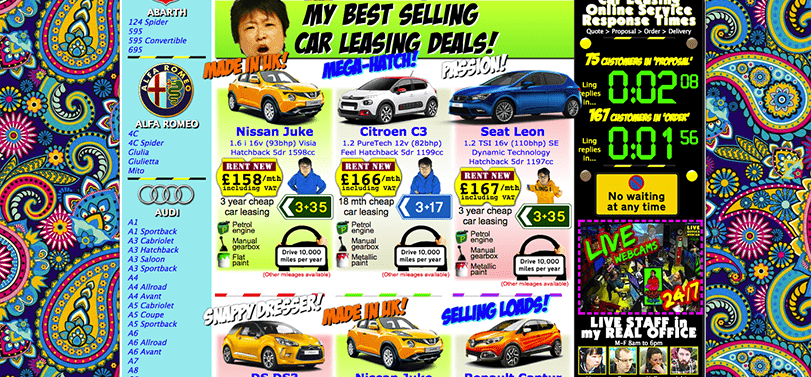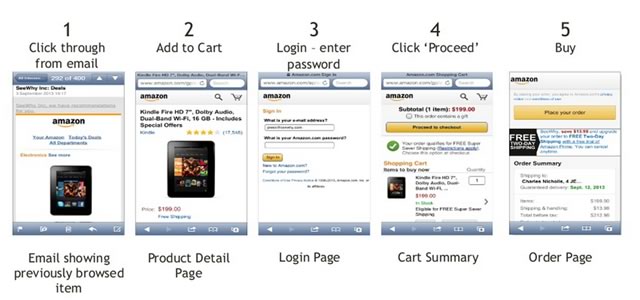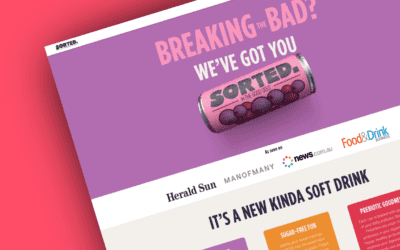Global eCommerce retail (as of Oct 2020) is a US$3.9 trillion market. Asia-Pacific region alone accounts for 2.45 trillion. Those are BIG numbers.
The average eCommerce conversion rate is a mere 3.5%. That’s 7 in every 200 visitors to your store who’ll make a purchase, on a good day.
Despite mobile’s rise in online purchasing, the conversion rate is the lowest among all devices at 1.35%.
Only 53% of marketers believe in conversion rate optimisation for sales growth.
Retailers with higher revenue outperform other stores on conversion rate because they invest in conversion optimisation.
I’ll take you through 10 conversion mistakes that are costing you eCommerce sales.
1. Visual clutter
I learned in photography that whitespace or negative space is a good thing. You need them to appreciate the subject of your composition.
Photographers like Ansel Adams knew about visual composition well before the internet. These principles have become a design philosophy.
No, I’m not talking about minimalism. I’m talking about reducing visual clutter. Let the eye follow visual elements in its natural browsing pattern.
Consider these two screens comparing eBay then and now. Which one is easier to browse?
Our brains have become accustomed to certain UX patterns and visual arrangements. Dare to change them only if you have a budget as big as Google or Apple.
I’ve come across one exception to this rule though. Ling from Ling’s cars has made it a selling point. She’s built a cult following with 66k+ visits per month (last checked Oct 2020).
2. Copy clarity
There’s a time and place to impress someone with your flair for creative writing.
Unfortunately, a website or product description copy is not the place for it.
Think of your online copy as a salesperson. No one likes a salesperson who talks too much.
But when the salesperson asks about your needs, you feel like they understand you.
Your website copy is no different from a salesperson. There is one crucial difference though. It’s not as dynamic as a human to change narrative mid-conversation.
So, your copy has to give the visitor exactly what they’re looking for. It’s okay to be clever about some headlines but only if your niche understands the context.
See if your copy answers these questions:
a) What does this product do?
b) How will I enjoy using it?
c) Potential use cases.
d) Product details – Think material, size, colours, price, dimensions, and potential use case.
When I was running Feastively meal kits, I wanted people to get excited about the dishes. Our menu changed every week. So the copy for recipes was written to excite a food critic. But customers were reluctant to try new dishes.
Know why? They wanted assurance that everyone in the family would be full after dinner. Mums wanted to know if kids the dishes would work for kids. Detailed ingredients, dietary preferences, best-before date, chilli levels and nutrition were some of the decision-driving aspects of the copy that had to be included on product detail pages.
It seems like a no-brainer. Every packaged food product already carries this information on its label.
But, few people look for this information on UberEats.
What’s the difference? The difference is context – planned buy vs spontaneous buy. More on this in another article.
3. Trust and confidence
This is a big one. Every economic transaction hinges on trust.
Establishing trust online with new customers is challenging. Anything new carries an inherent risk.
Familiarity, assurance and overall interaction experience are trust signals that give people the confidence to carry on shopping.
I remember when the Feastively store was still new, we lost roughly 30% sales in a week due to a misconfigured coupon. Follow-up attempts couldn’t recover these carts.
Some trust eroding elements on an eCommerce store are (and not limited to):
a) Typos or incorrect use of language
b) Errors on the website
c) Coupons not working
d) No endorsements or reviews
e) Insecure connection
Trust seals and marks are significant drivers of buyer confidence.
4. Incorrect details
If you paid attention to point #2 then you should already have enough detail about the product.
But what about incorrect details. I’ve seen this happen in retail e-commerce stores with thousands of SKUs. Someone sits in an office and fills out or uploads product description en masse.
Next thing you know, 10 products have the same description. When in fact, they are different products.
Data management and governance is a big problem at large stores. The problem becomes bigger when it puts customers off the sale.
At a physical store, you expect the salesperson to be honest about the product.
This simple truth cost a dealership the sale of a $17,000 motorcycle. The salesperson quoted a price with a feature that is a $1000 add-on. When I got the contract of sale the add-on was missing. The salesperson had confused the stock items. He had misrepresented the product.
5. Confusing path to purchase
Where am I?
It’s not a good sign if your customers are asking that question in the middle of a purchase journey.
Navigation clarity is as important as communication clarity.
The generally accepted online ordering workflow is evident in this graphic by CXL Institute on Amazon.
Altering this flow and adding unnecessary steps in the workflow cause confusion. Confusion leads to doubt and doubt leads to cart abandonment.
If your store has several categories it can be easy for a customer to get lost in the “aisles” or category pages. Give them a way to find their way back with breadcrumbs.
6. Not optimised for mobile
In 2019 Australian businesses did 33% of online sales on mobile (source: Paypal’s mCommerce report). This is up from 25% in 2018. This figure is likely to grow in 2021.
The US consumer is already ahead of the curve with as much as 40% of online sales coming from mobile.
Mobile screens are not a smaller version of your desktop screen.
Mobile usage differs from laptop or even tablet usage. Some differences include:
a) On the move content consumption
b) One-handed operation
c) Smaller viewport – think larger font and buttons
d) Highly tactile interaction
e) Short/spontaneous interaction
Delivering the right information is key to keep customers moving through the funnel. Cognitive overload in the sales path is a turn-off. Make it easier to interact with your store with buttons in all the right places and larger text size. Use tabs instead of long scrolling.
Responsive web design is good, a mobile-first design is even better.
7. Product image quality
The tactile sensory experience (i.e. touching a product) is missing in online shopping. So the online shopping experience has to overdeliver on at least one other sense.
Can you guess which one?
If you guessed “sight” then you’re spot on.
Detailed product at different angles will meet the consumer’s curiosity. Seeing it worn by someone else helps them visualise the product on themselves.
Blurry or pixelated images show a lack of attention to detail. If you missed this, will you follow my order notes?
Some large retail stores are notorious for uploading a single image of the product.
If I can’t be at the store I want to know what that tent looks like on the inside. How the poles fold. The canvas texture. Whether it can accommodate a 6ft tall person etc.
The product imagery has to replace what the customer is missing out on – sensory experience.
8. Poor customer support
Customer support falls into 3 main areas:
a) Pre-sales: Someone wants to know more to decide if your product or service is right for them.
b) During purchase: They know your product or store is right for them. But they might want to learn more about something specific.
c) Post-sales: There was a problem with the order, warranty issues or returns.
Great customer service can be your unfair advantage. Diony from Paperform has turned customer service into an advantage for her business.
Look at Iconic – 30-day returns, no questions asked for clothing and apparel. Shopping online can be tricky. They’ve eliminated the trickiness by offering a generous return period.
But nothing kills sales faster than poor customer support.
Having several communication options is a must-have. Email is too passive.
Phone and live chat are conversion boosters. According to Forrester research, customers who interact on live chat are 2.8x more likely to convert than those who don’t.
But communication channel aside, first commit to being there for your customers.
9. Price transparency
Pricing is a challenging topic. I’m referring to how to price your products. Price transparency is easy yet often overlooked in stores.
Pricing transparency deals with:
a) Shipping/delivery fee (and free shipping criteria)
b) Product variation price changes – does the red one cost more than the black one?
c) Taxes
d) Applicable discounts (sale / special offers etc)
As much as possible, offer one price upfront when people are in the middle of the purchase process.
The product detail page should have an all-inclusive price. It helps customers judge value based on one figure. Fudge the price and watch them run away.
I find Wiggle.com.au notorious for revealing a big delivery fee at checkout. Even though they got me onto the website from a price comparison site, the delivery fee nullifies the bargain benefit.
According to Shotfarm’s own research, unexpected costs are one of the top reasons why (61%) people abandon their online shopping cart (See infographic in summary)
10. No urgency
Now let’s look at the tail end of the purchase process. Your customers have arrived at your online store, they’ve browsed a few products. They’ve even started adding products to the cart.
And then the phone rings. The conversation goes on for 20 minutes. They forget about their purchase.
But what do you think would have happened if they had a special offer waiting for them with free shipping and upgrade?
They would have remembered the offer. They’d make it a point to come back and complete the purchase. If the offer was only available for 30 seconds they might even have deferred taking the phone call.
Urgency and scarcity are drivers of action. No one wants to miss out when the offer is too good to pass up.
Not long ago I found myself buying a $299 professional development course bundle for just $89. The TV was on and yet this offer had my undivided attention.
In the back of my mind, I wanted to see whether it would still be available today. But I also knew that if it wasn’t I would have lost an opportunity for further learning. I took up the offer.
Similarly, limited stock creates FOMO. FOMO encourages people to use their gut and heart to make the purchase. There simply isn’t enough time to rationalise over all the options.
Summary
With so many things to consider, where do you begin?
Fix low hanging fruit like images, trust signals, pricing etc straight away.
To address other issues a methodical approach. Use analytics, screen recordings and user interviews to determine the problem areas.
Have a look at this infographic from Shotfarm (now syndigo) for more data on conversion detractors.











